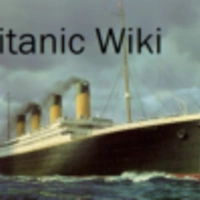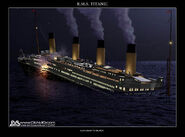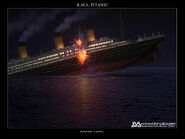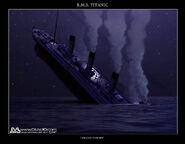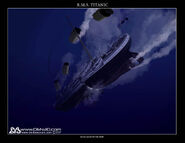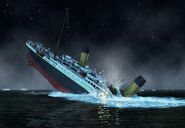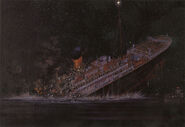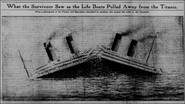Tag: Visual edit |
(Undo revision 37680 by 50.202.18.202 (talk)) |
||
| Line 5: | Line 5: | ||
===Theory 1-Today's Theory=== |
===Theory 1-Today's Theory=== |
||
| + | The ship was at an angle of 25 degrees when her lights went out at 2:18. The ship suddenly snapped in two pieces, just around the third funnel, sending the sinking stern crashing down into the water. Water surged into the bow and stern of the ship through the huge cracks, causing the bow section to sink beneath the waves. The double bottom separates and the stern rises to the high angle of 60-70 degrees, where it then disappeared beneath the waves. |
||
| − | no |
||
yeah you right |
yeah you right |
||
Revision as of 21:41, 19 December 2019
The RMS Titanic breaking in half was an event during it's sinking. It occurred just before the Titanic went underwater, when the ship suddenly snapped in two pieces, sending the sinking stern crashing down into the water and allowing the bow section two sink beneath the waves. Many survivors, such as Charles Lightoller didn't see the break up, as the lights suddenly went out, plunging the ship into total darkness. However, others like Jack Thayer saw cracks forming in the ship. It was unknown to the common people before the wreck was discovered in 1985. Many questions were asked about the break-up. "Did the break-up occur in front of the third funnel or behind it?" "Did the bow rise itself up?" Nobody knows how the break-up occurred, but scientists have confirmed that it did happen, and it was caused by the uneven distribution of weight in the Titanic's stern.
Event
The breakup took place at 2:17 or 2:18 AM. It started with the ship's lights going out, plunging everything into total darkness. Rumbling and metallic screeching then shook the ship. The ship then broke in two pieces. Around here, it's debated about how the break-up occurred.
Theory 1-Today's Theory
The ship was at an angle of 25 degrees when her lights went out at 2:18. The ship suddenly snapped in two pieces, just around the third funnel, sending the sinking stern crashing down into the water. Water surged into the bow and stern of the ship through the huge cracks, causing the bow section to sink beneath the waves. The double bottom separates and the stern rises to the high angle of 60-70 degrees, where it then disappeared beneath the waves.
yeah you right
Theory 2-Lower Break
The ship was at an angle of 20 degrees when her lights went out at 2:18. The ship suddenly snapped in two pieces, sending the sinking stern crashing down into the water. Water surged into the bow and stern of the ship through the huge cracks, causing both to sink even faster. The double bottom then separated from the bow, and the bow disappeared beneath the waves. The stern, with its propellers still on the water's surface, then sank underwater from the fourth funnel down.
Theory 3-Low Angle Sinking Theory
The ship was at an angle of 20-25 degrees when her lights went out at 2:18. The ship suddenly snapped in two pieces, sending the sinking stern falling slowly into the water. Water surged into the bow and stern of the ship through the huge cracks, causing the bow to sink below the waves. The double bottom still attached to both parts, pulled the stern to an angle of 20 degrees. Once at 20 degrees, it sank in a straight direction and disappeared beneath the waves.
Theory 4-Cameron's Movie Theory
The ship was at an angle of 45 degrees when her lights went out at 2:17. The ship suddenly snapped in two pieces, sending the sinking stern crashing down into the water, creating a huge wave, killing people on the decks and crushing people in the water. Water surged into the bow and stern of the ship through the huge cracks, causing the bow section to sink beneath the waves. The double bottom, still attached to the almost afloat stern, pulled the stern to an 80-90 degree angle, where it bobbed momentarily for a minute. Once the double bottom separated and the bow went down, the stern dove straight down beneath the waves.
Theory 5-V-Split Theory
The ship was at an angle of 11 degrees at 2:17. The ship then slowly began to crack and break apart slowly. She fell back slowly five degrees, and water poured through the crack. With this new flooding area, it increased weight in between the two sections, bending the two broken parts together. When the double bottom failed, it allowed water to pour in pulling the ship into a V-shape, though the bow still stayed all the way underwater. The two parts tangled together sank underwater together, until they separated underwater.
Theory 6-No Fall
The ship was at an angle of 30 degrees when her lights went out at 2:18. The ship suddenly cracked to the double bottom but stayed in the upright position. The whole ship then sank underwater at 50 degrees in a straightforward direction, and the two parts then separated underwater.
Theory 7-Fire Theory
With any of the six previous theory's, many survivors claimed to see a small explosion or a small fire occurring in the hull of the ship when she split in two. If this is true, the explosion was most likely caused by boilers exploding due to the breakup. If it was a small fire, it may have been caused by broken electrical wires snapped during the breakup, which showered sparks on flammable interiors. Sparks were reported to have flown from the broken electrical wires.
Gallery
Trivia
- The breakup was first seen in film in the 1996 Miniseries Titanic.
- Theories 1,2,3 and 5 may have been the most likely ways the ship split and sank.
- A video game called Hidden Mysteries Titanic claimed that the ship broke in half at 1:30. This is not historically accurate.
- Titanic was thought to have broken either right behind the third funnel, right in front of it, or right on it. hi
